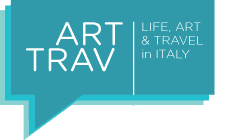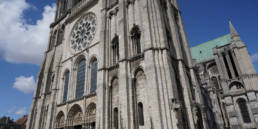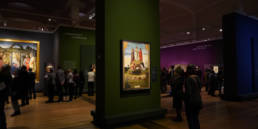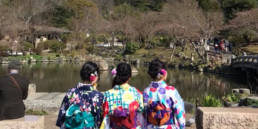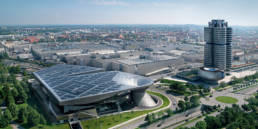On a visit to Copenhagen, I learned about Scandinavian design, coming to understand the shapes and underlying concepts that can impact our daily lives for the better.
This itinerary for three days in Copenhagen is a voyage through Danish design, art and architecture that, if we let it sink in, can change the way we live anywhere in the world.
The influence of Danish design on our contemporary spaces
Before jumping into the travel ideas, allow me this reflection. I’ve been thinking about how the Danish design I saw in Copenhagen has strongly influenced the way our spaces worldwide look today. Some of the driving elements of Danish design, like functional rather than ornate furniture serving small spaces, as well as some of the more iconic shapes that are easily reproduced by mass manufacture, have stuck. Other aspects have been misinterpreted or have evolved with time for one reason or another. Just one example: we erroneously associate Scandinavian style with neutral colours and impersonal spaces, but that’s Minimalism or just a lack of daring; take one look at the turquoise furniture and walls of Arne Jacobsen’s hotel rooms at SAS House and the materiality of wood in the Finn Juhl house and you’ll see colour and pattern play a strong role in good Danish design.
I think all this is relevant in this post-Covid era in which many of us are re-evaluating the space in which we live, and perhaps now also work. Personally, I’m a bit of an aesthete: lockdown influenced my move from a ground floor apartment in Florence to a more light-filled one in its hills when I realized that light and trees were “decorating features” that I couldn’t live without. This trip to Copenhagen amongst design museums, furniture stores and modern architecture contributed to my desire to understand what elements contribute to making a space pleasant for me and how these same concepts developed fifty to eighty years ago in Denmark.
SAS House Room 606 by Arne Jabsen (now a Radisson Collection hotel) / Ph. Alexandra Korey
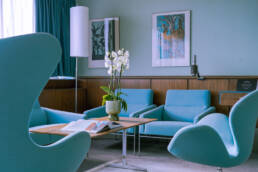
In central Copenhagen: museum, shops and the first design hotel
MUSEUMS / I’d start any exploration of design in Copenhagen at the Design Museum Danmark, which opened at the end of the 19th century to promote quality and design in Danish industry as well as to sensitize the public towards good design. The museum reopened last year after renovation with a new layout that includes rotating temporary exhibitions and selections from the permanent collection in a series of rooms. The temporary shows probe on-trend themes like working from home, the resurgence of mending, or the use of alternative materials for architecture and textiles with short, creative displays that raise these issues for anyone not familiar with them, providing food for thought for future research.
The permanent collection at the Design Museum is shown in a rotating display through a series of rooms tracing the last hundred years of design in a roughly chronological order that also is divided up into either shapes or historical movements. So we learn about Constructivism but also Pop art, conceptual art or organic shapes. Objects are complimented by loans from the Kunsten Museum of Modern Art Aalborg and the Louisiana Museum of Modern Art in order to show the links amongst design, art and architecture. There’s a very interesting film made in the 1950s when Danish Design presented itself to the rest of the world and indeed became an internationally appreciated export item. We learn about the role of historical research and craftsmanship on the new designs. Moving our way through the rooms, we see how organic shapes, materials and colour all play roles in Danish design as it evolved over the last century and can admire numerous iconic pieces.
SHOP / The design museum has a large café featuring a range of different famous chairs, so if you were looking at something and wondering if it’s comfortable enough for your dining room, sit down for a coffee and find out for yourself. Or… head out to the source of that furniture from some of the famous brands who continue to manufacture designs with the highest quality standards. For example, Fritz Hansen, whose flagship store is right downtown, produces the famous egg chair by Arne Jacobsen, and has worked with designers Poul Kjærholm, Hans J. Wegner and Piet Hein, all names you’ll recognize from the museum. A visit to the store allows you to see suggested contemporary ambiences for the pieces (even just through the window if you prefer), or can be an opportunity to choose a special souvenir. It doesn’t have to be a sofa – I’m obsessed, for example, with the Ikebana vase series by Fritz Hansen.

Want something certainly portable? How about Georg Jensen, a famous name whose stainless steel vases and candle-holders are museum-worthy and also suitcase-safe. They also make discreet jewelry in silver and gold and their products are perfect as timeless wedding gifts; visit their store near Kongens Nytorv metro (a station you’ll soon realize is the node you will pass through a half dozen times per day). Another idea is to bring home some light! I’ve been ogling the metal PH5 lamp by Louis Poulsen for quite some time (of course it’s displayed in the design museum) but it’s an investment in DKK just as much as it is in Euros. I satisfied my craving for Danish lighting at accessible prices with a purchase from a young brand called Dyberg Larsen, spotted in a shop and purchased directly from them online – a nice quality metal lamp that will remind me of Copenhagen every time I sit below its hygge beam. Finally, if you have time, follow this list of secondhand and vintage shopping in Copenhagen on the official Visit Copenhagen website for some housewares, furniture and clothing to take home.
HOTEL / To complete my exploration of iconic design in central Copenhagen, I headed to the SAS House, now the Radisson Collection Royal Hotel, which was entirely designed by Arne Jacobsen from the building down to the silverware! This was an opportunity to take a deep dive into the life and work of Jacobsen, who attended the Royal Academy to study architecture in the 1920s. He visited Italy and France, and learned from professors and students who rejected past styles, learned about the classics and loved Danish craftsmanship. He was influenced by Constructivist architecture, in which geometric lines are at the service of everyday life (the prime example of this movement was Ludwig Mies van der Rohe) but he also had a thing for nature, using plants as dividers in the family home he built for himself and his wife. In 1955, SAS airlines was promoting Copenhagen as the new center for jet age travel and commissioned a modern hotel for this. The SAS House occupies a wedge of property across from the central train station, using a low base topped with a geometric skyscraper to house guest rooms with stunning views and light streaming in the full walls of windows. The exterior of the building hasn’t changed at all – it cannot, as its heritage listed – and still sports the SAS sign, with Radisson’s own sign placed only at street level.
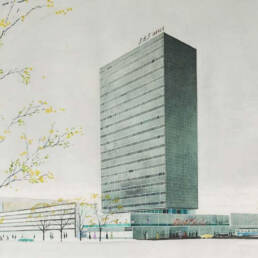
When it was inaugurated in 1960, this hotel was the picture of modernity. Imagine ladies in traveling outfits with pillbox hats checking in, followed by porters with piles of luggage, sipping martinis in custom silver chalices while seated in egg-shaped chairs in a grand lobby. They powder their noses in the oh-so-vintage pink washrooms down a spiral set of stairs –these washrooms may be one of the coolest things in this hotel, perfectly preserved. They visit the city, everything at their fingertips. Ready to leave, they check in to their flight and wait for it in the lounge of the hotel, which acted as an extension of the airport, connected by shuttle bus. And the rooms, oh the rooms…
Not everyone was enamoured with Jacobsen’s décor. Commissioned from one general manager of SAS, the next director to come around, Alberto Kappenberger, did everything to remove traces of the very modern design from SAS House already in the early 60s. He rubbed his hands with glee and issued a press release when US VP Lyndon B. Johnson visited and demanded in advance that Jacobsen’s bizarre chairs be removed from his suite before he arrived. Chairs that nowadays easily run you €2500 and are in design museums around the world. While the dismantling continued, with a floral update in the 70s, and total change of furniture in the 1990s, luckily someone had the foresight to keep one room, suite number 606, just as it Jacobsen designed it, and that’s the room I asked to visit.
It’s stunning. That’s not a word I often use, but how else to describe the light in this room, the eggshell walls and turquoise bulbous chairs, the dark veined wood and the studied simplicity of this space? Alongside the now-iconic chairs is the custom-designed furniture, like the headboard with a runner for the lamps that can move closer to the reading guest, or the desk that opens up to become a mirrored make-up table.
Room 606 is a privilege to visit, and it’s a free option for all guests of the Radisson Collection hotel. If you’re not staying at this modern design hotel, you can contact the concierge to request a visit, which has a small cost and limited availability.
Exploring the new Copenhagen: architecture
In 2023, Copenhagen is the UNESCO World Capital of Architecture and will examine the themes of sustainability and urban development, in which the city certainly exceeds. The Danish Architecture Center (DAC) is a great place to start thinking about the Scandinavian approach to public spaces, urban planning, buildings of every sort and their materials and use. It’s a bit geeky but in my opinion not too niche to be a fascinating museum. Even the building itself is interesting since it bridges a busy road and is home also to offices and a gym, ideal for people-watching. If time is of the essence, you may also like to know that it’s open late on Thursday nights, and it’s possible to quickly escape the upper galleries by taking a big slide to the ground floor (just kidding about the escape; the 4-story slide is by Carsten Höller and is part of the permanent collection).
Nordhavn, a new multi-use urban area, features a rooftop playground

A rotating schedule of exhibitions examine themes or architects, while a new permanent exhibition on Danish architecture is set to open in late Spring 2023. I saw an exhibit of works by Vilhelm Lauritzen Architects that looked at their ideas behind diverse buildings like a concert hall, airport, an innovative school, a clover-shaped hospital and clever student housing. Danes truly are a step ahead.
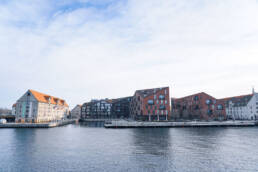
What I found useful about the DAC was that I could spot buildings “in the wild” that I first saw in the museum. Copenhagen is undergoing massive expansion and requalification of industrial areas into mixed-use ones, so as soon as you head beyond the immediate tourist center, you can find examples of how architects are weaving the new urban fabric. For example, crossing the recently built pedestrian and bike bridge from Nyhavn to Christianshavn to sample the upscale burgers (veg and pescatarian options!) at Popl, Noma’s “popular project,” I spotted a new housing development featured in the museum. Sitting wide upon the harbour and discreet in red brick, Krøyer’s Square was the design settled upon after numerous other proposals had locals up in arms. Vilhelm Lauritzen Architects used co-design workshops with citizens to find a solution that looks like it has always been there, not too high, with direct access to the water and gardens.

We hopped the Metro to check out Nordavn – by this time we’d learned that “havn” means harbour and sounds more like “hown”, not “haven” as you’d think… Spanning the last two stations on one of the metro lines, the trip was surprisingly short to this new urban district. This mixed-purpose space combines offices and condos as well as recreational spaces. The clean water of Copenhagen’s harbours make it possible to bathe here year-round; in the summer, the wooden amphitheatre along the water must be packed with sunbathers and swimmers, while visiting in early March, I got to witness winter bathers, brave locals who wish to test the health benefits of cold water. Overlooking the bathing area are the Portland Towers (that remind me of Chicago’s Marina towers or “corn cobs”, I wonder if the reference is deliberate); this was the first building to be completed in the new area and is a clever conversion of cement silos into office buildings.
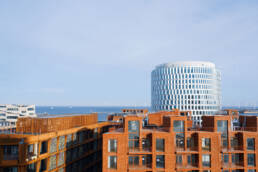
We headed over to Konditaget Lüders which houses a supermarket, parking lot, and extensive rooftop playground. You can challenge yourself on the stairs up using a giant timer that encourages faster climbing. Once up high, bracing yourself against the wind, you can jump, climb and swing to your heart’s content, or just enjoy the view. From here you can clearly see the Tip of Nordø, another building I recognized from the show at the DAC (at this point I felt like an insider). An office building at the very tip of the quay, the angled metal façade uses reflective light to control the inside temperature. A public space in the form of a central winter garden will be open to the public when the building is completed later this year.
If you’ve still got time and a taste for more architecture, the former industrial area occupied by Carlsberg – the beer – is being requalified. It’s got all the charm of a 19th-century brick area and a ton of history wrapped into it. Here, too, it’ll be a mixed use area, about 50% residential and the rest offices, stores, and recreation. Still very much a construction zone, if you return in a few years, chances are it’ll be finished and very… hopping (excuse the pun).
Up the North coast of Copenhagen: bucolic museums and seafront design
With the goal of increasing my knowledge of modern design and architecture in Copenhagen, my plans for the long wekend skipped over some of the main tourist sites and surely beautiful museums in favour of a day trip to an area up the coast. Here, I wanted to see two architectural gems by Arne Jacobsen, as well as two modern museums and their sculpture gardens. It was a very full, long day but we squeezed it all in thanks to the magic of two wheels: we rented bikes and brought them on the metro and train, and biked between locations.
There’s a Louisiana Museum of Modern Art that is not in the United States but in Humlebæk, North Sealand, about an hour on the train from the city center. The museum was founded in the 1950s by Knud Jensen, who wanted to create a space that felt like a home in which Danes could experience modern art. He found a 19th-century country house and large property for his museum, which would involve a contemporary expansion, and kept its name, Louisiana (named for the previous owner’s three wives, all called Louise).
The museum opens at 11am and I’d recommend visiting on a sunny morning if you can, because that’s when the light will be best in the sculpture garden (we had shade in the late afternoon). The works by international and recognizable artists find homes in the garden, sometimes integrated into the landscape, other times in contrast with the watery horizon, and other times almost hidden amongst the bushes. Head inside and you’ll see that the architecture is as notable as the always expanding and rotating collection: the building was specifically designed to enhance connections between inside and outside, nature and art. For example, a sculpture by Giacometti strides in front of a wall of windows giving on to the property’s small lake and willow tree that the founder insisted was a major feature he wanted to highlight. The museum has an excellent and free audioguide that I highly recommend as it helped me spot a number of details in the construction, such as the way windows were installed on a dark base, but disappear into the ceiling. It’s certainly a space that offers opportunity for contemplation.
The other museum that I wanted to visit along the northern coast is Ordrupgaard, which features contemporary exhibitions as well as a strong permanent collection of 19th-century Danish and French paintings housed in three wings, one of which is a clear signature work of Zaha Hadid. There’s a charming sculpture garden here, too, with a dozen or so works designed for human interaction though, I’d say, also very well integrated into nature, sometimes so much that you can’t find them!

But what really spurred my trip here was a visit to the home of furniture designer Finn Juhl. Juhl’s house neighboured the manor house that was the nucleus of the museum’s collection, and upon his death it was incorporated into the property and opened to the public. It’s a tiny little cottage, built on a human scale, full of light and colour. The furniture is organic, not imposing, arranged to create multi-functional spaces for living, eating, reading and working. A joyful collection of small format art decorates the walls. Not everything in this home is what we’d want to live with today – the kitchen seems a bit sacrificed at the back of the house, and a distinct mildew odour is wafting up from the basement – but I’d say it’s solid inspiration for anyone decorating a welcoming small space.
Ordrupgaard is about a 15-20 minute walk from the coast, and it’s along its wind-buffeted bike path that I traveled to see two more Arne Jacobsen masterpieces. The Skovshoved petrol station was built in 1936 upon commission from Texaco, who intended it as a model for all their stations but ended up building just the one. At the very beginning of the jet age, this building is fabulously futuristic. From a simple rectangular building covered in white tiles, an elliptical covering juts out, supported by a single column. Recently restored (but a bit dirty under the top, unfortunately), it now houses a buzzing retro ice-cream shop.
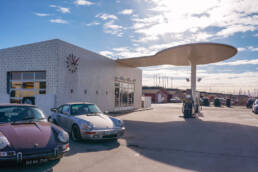
Another few kilometers to the North is another work from the 1930s, the Bella Vista estate in Øresund. Arne Jacobsen here developed homes not in a way that imposed his views, but rather thinking about what would be the best way to take advantage of this particular location and optimize the open views of the sea. The design may be functionalist, but it’s so well thought out and thoroughly modern that it seems luxurious now. The buildings are staggered to incorporate large terraces suitable for outdoor dining and the view is maximized by windows that wrap around corners. The housing estate extends down to the water on the other side with a beach club, and to one side with a movie theatre. I actually checked to see if there might be an Airbnb in this building because a weekend here on the coast would be the ultimate vintage experience, but alas, I didn’t find anything. Let me know if you do!
Practical info about travel in Copenhagen
Arriving: If you’re flying into Copenhagen, which is most likely unless you’re taking the train around Europe, you’ll be pleased to hear that the airport is basically in the city. Pro tip, get a window seat because on a clear day you can observe all the fields, roads and tiny houses of the low countries on the approach to Denmark. From inside the air terminal, get a Metro ticket (about €4 to the city center) and hop on the very efficient system to be downtown in less than 13 minutes.
Getting around: The metro and train system in the Copenhagen area is absolutely brilliant. Single metro tickets aren’t cheap, so either get a multi-day pass or their electronic card similar to London’s Oyster. Bike sharing is everywhere as are bike lanes, so you can easily download and register on an app for that to get around like a local. Note that bike lanes go only in one direction, that of traffic, on the appropriate side of the road and that google maps will actually plot a route on bike lanes for you! If you want to take the metro with your bike, remember to buy a ticket for the bike and that you can’t do this at rush hours (this is clearly posted on signs in the stations). Finally, if you need a taxi, there are various apps for that; I used Viggo, reputed the best price, and a lovely lady in a Tesla accompanied me where I needed to go at an ungodly hour.
The Copenhagen card: All good cities have a “card” and Copenhagen is a leader in that. The Copenhagen card combines museum entries and public transportation. Two versions are available depending on how far you wish to travel on the train and how many museums attractions you want to have included. The card is actually an app, so you’ll need to have your phone charged up to show the QR code or bar code wherever needed. With the card I felt like I could spend a bit less time in some museums or rather just go to the parts I was interested in, as well as hop on and off the metro to quickly go anywhere in and beyond town.
For my visit to Copenhagen, I was assisted by the official tourism website www.visitcopenhagen.com/ whose staff kindly provided me with the Copenhagen Card. With thanks to Giuseppe for his invaluable tips and warm welcome.
Sign up to receive future blog posts by email
Alexandra Korey
Alexandra Korey aka @arttrav on social media, is a Florence-based writer and digital consultant. Her blog, ArtTrav has been online since 2004.
Related Posts
September 18, 2019
Re-Discovering Chartres: the Gothic Cathedral and Beyond
March 31, 2019
Mantegna and Bellini – Berlin exhibition review
May 1, 2018
Four days in Kyoto, Japan
April 26, 2018
